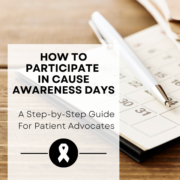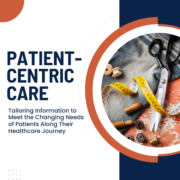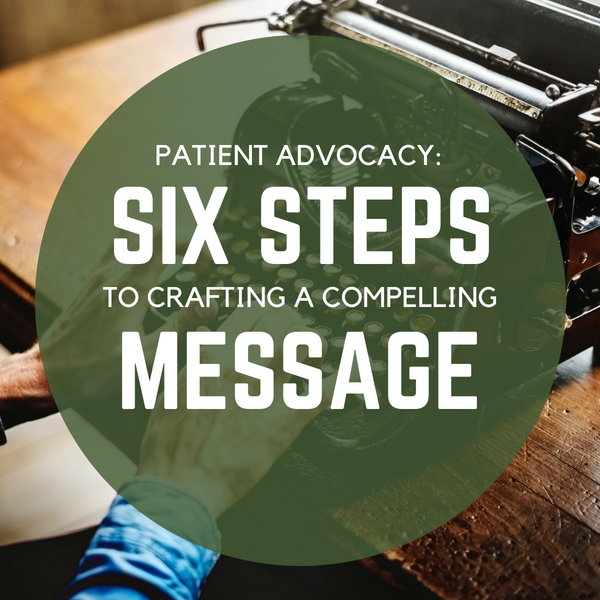How To Participate in Cause Awareness Days: A Step-by-Step Guide For Patient Advocates
Taking part in cause awareness days can be a great way to get your message out. Cause awareness days are specific days (or weeks/months) dedicated to raising awareness and educating the public about a particular cause. People and organizations get to join together, use their collective voices, and make a difference.
In this step-by-step guide, I’ll show you how to participate in cause awareness days more effectively to make a meaningful impact on behalf of your community.
Step 1: Identify relevant cause awareness days
Research and make a list of cause awareness days related to your disease or condition. This information can be found online and through patient advocacy groups. Several websites provide calendars of awareness days, such as the National Health Observances calendar maintained by the US Department of Health and Human Services and PEN’s Cancer Awareness Calendar 2023.
Tip: Don’t limit yourself to disease-specific awareness days. There are many ways to expand your advocacy efforts and engage a wider audience, for example, during days such as World Mental Health Day, International Women’s Day, and World Sleep Day.
Step 2: Plan your strategy
Decide how you will participate in each cause awareness day. Think about different ways you can make an impact, such as sharing educational resources, personal stories, or statistics, hosting fundraising events, speaking engagements, and conducting community outreach. Create a calendar to track your activities and stay organized.
Step 3: Create your content
Make your content engaging by following these tips:
- Use graphics, videos, or infographics to make your content more visually appealing and engaging. Be sure to use high-quality images and videos that are relevant to your cause.
- Keep it concise. Attention spans are short, so keep your content short and to the point. Use bullet points and headers to break up text and make it easier to read.
- Be sure to fact-check your content and cite credible sources. Misinformation can damage your credibility and harm your cause.
- Tell a story. Stories are powerful tools for creating emotional connections with your audience. Share personal stories or anecdotes that help illustrate the impact of your cause.
- Provide actionable steps. Your content should inspire your audience to take action. Provide actionable next steps to get involved or support your cause.
Step 4: Spread the word
A crucial part of raising awareness is spreading the word. To share your content effectively, follow these tips:
- Share your content on your social media channels, and use hashtags to increase visibility.
- Email is still an effective way to communicate with your audience. If you have a list of email subscribers, share your content with them and encourage them to share it with their networks.
- Collaborate with other patient advocates, organizations, or influencers who are participating in the cause awareness day. This can help amplify your activities and increase the reach of your message.
- Reach out to local media outlets to share your story. Pitch a story to a reporter or submit a press release to local news outlets.
- If you have a budget, consider using paid advertising to reach a more targeted audience.
Step 5: Participate on the day
On the day participate in the activities you have planned. Don’t forget to use relevant hashtags and tag other organizations or individuals who are also participating. Be sure to respond to comments, messages, and mentions on social media. This can help build relationships and trust with your audience.
Step 6: Follow up
This final step is often overlooked. However, to my mind, it’s one of the most valuable aspects of participating in cause awareness days. This is because it helps to build a community of advocates who are passionate about the cause and can support each other in their efforts.
Here are some ideas to follow up and build on the momentum of the day:
- Send a message to those who participated in your activities and thank them for their support. Let them know how much their support means to you and to the cause.
- Share the number of people you have reached with your online activities, your engagement rate, and other relevant metrics to demonstrate the impact of your combined efforts.
- Stay connected with those who participated in your activities and build relationships with them. Follow up with them throughout the year and invite them to participate in future activities.
Participating in cause awareness days is a powerful way for patient advocates to bring attention to critical issues that affect their communities, inspire change, and motivate others to join them. Yes, it takes planning and time, but the effort you put in is worthwhile when it contributes to the creation of a movement of passionate advocates that are committed to the same cause.

A Stanford Medicine X e-Patient scholar, Marie Ennis O’Connor is an internationally recognized keynote speaker, writer, and consultant on global trends in patient engagement, digital health and participatory medicine. Marie’s work is informed by her passion for embedding the patient voice at the heart of healthcare values. She writes about the experience of transitioning from breast cancer patient to advocate on her award-winning blog Journeying Beyond Breast Cancer.










